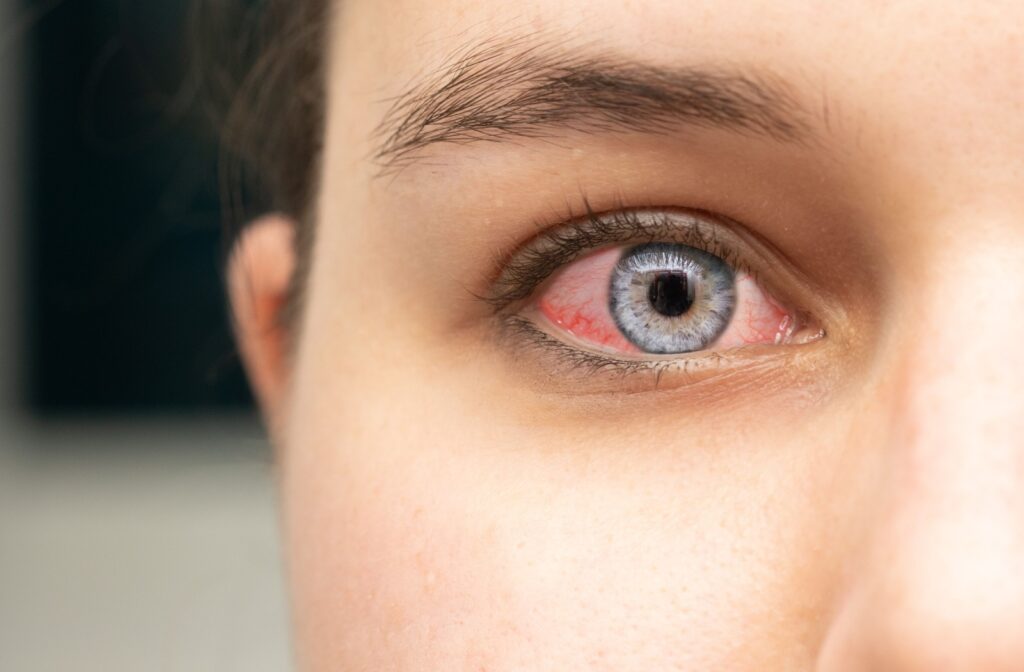Waking up to red, irritated eyes can be an alarming experience. Your first thought might be “pink eye,” a common condition that many of us associate with redness and discomfort. But several other eye conditions are often mistaken for pink eye. It’s very easy to misdiagnose eye symptoms without professional guidance, and understanding the nuances can make a big difference in addressing the issue promptly and effectively.
Here are some common conditions that are often confused with pink eye:
- Allergies
- Dry eye
- Blepharitis
- Subconjunctival hemorrhage
- Styes
Each of these conditions can present symptoms that resemble pink eye, but they require unique approaches to diagnosis and treatment.
The Importance of an Accurate Diagnosis
Pink eye, also known as conjunctivitis, shares common symptoms such as redness, swelling, itching, and discharge with several other eye conditions. This overlap can make it tricky to determine the exact issue without professional evaluation. Misidentifying the cause could lead to incorrect treatments, which might not only fail to resolve the problem but could also prolong discomfort.
Proper diagnosis enables eye care professionals to develop a targeted treatment plan, addressing your symptoms directly and facilitating your eyes’ healing process as efficiently as possible. Whether it’s a bacterial issue, an allergic reaction, or something else entirely, knowing the root cause is essential.
Conditions Similar to Pink Eye
When your eyes are red and irritated, it’s natural to assume it must be conjunctivitis. However, pink eye is a distinct condition with specific causes and symptoms. To confuse this more, sometimes people will use the term “pink eye” to refer to any condition that causes your eye to turn red.
Let’s explore some common lookalikes to understand how they differ from pink eye.
Allergies
Allergic conjunctivitis is one of the most confused conditions with viral or bacterial pink eye. It develops when allergens, such as pollen or pet dander, irritate the eyes. This immune response leads to redness, itching, and watery eyes. While this is technically a type of pink eye (conjunctivitis), there are a few key ways to tell allergic conjunctivitis apart:
- Allergies often affect both eyes simultaneously, unlike contagious pink eye, which may start in one eye.
- Symptoms like sneezing, itchy nose, and nasal congestion typically accompany allergies.
- Allergies cause itchiness, while bacterial or viral pink eye usually causes burning or soreness.
Antihistamines, artificial tears, and avoiding allergens are the go-to treatments for allergies, whereas bacterial pink eye requires antibiotics.
Dry Eye
Dry eye occurs when your eyes don’t produce enough tears or when the tears you do have evaporate too quickly, disrupting the tear film. This can cause redness, irritation, and a burning sensation, often mistaken for pink eye. However, dry eye differs in the following ways:
- Dry eye symptoms are chronic and persistent, rather than sudden.
- Unlike pink eye, dry eyes don’t typically produce significant discharge.
- Pink eye, especially bacterial or viral, clears with treatment or time, whereas dry eye is managed long-term.
Managing dry eye symptoms can include artificial tears, warm compresses, and in-office therapies prescribed by your eye doctor for long-term relief.

Blepharitis
Blepharitis involves chronic inflammation of the eyelids, often caused by clogged oil glands or conditions such as rosacea. The symptoms often overlap with pink eye, including red and swollen eyes, but there are key distinctions:
- Blepharitis presents with crusty buildup or flakes around the lashes, something pink eye doesn’t usually cause.
- While pink eye develops suddenly, blepharitis often fluctuates between periods of flare-ups and periods of minimal symptoms.
- Pink eye targets the conjunctiva (the clear tissue covering the white of the eye), whereas blepharitis is focused on the eyelids.
Blepharitis is often managed through eyelid hygiene, such as cleaning with specialized wipes or using warm compresses.
Subconjunctival Hemorrhage
A bright red blotch on the surface of your eye may look concerning, but it could simply be a subconjunctival hemorrhage, which occurs when a small blood vessel bursts. This can be caused by sneezing, coughing, or minor trauma, and while it may be alarming, it’s usually harmless.
The differences include:
- The redness in a subconjunctival hemorrhage appears as a distinct, bright red patch, while pink eye redness is more diffuse.
- Subconjunctival hemorrhage doesn’t involve swelling, discomfort, or discharge like pink eye often does.
This condition typically resolves on its own in a few days to weeks, but a visit to the eye doctor is always a good idea to rule out other concerns.
Styes
A stye is a small, pus-filled bump that develops on the edge or inside of your eyelid. Like pink eye, it can cause redness, swelling, and localized pain, but the differences are noticeable:
- A stye is localized and presents as a specific bump, unlike the diffuse swelling of pink eye.
- Styes may be tender to the touch and form crusts directly over the infected gland.
While styes often heal with warm compresses, persistent or recurring cases may require evaluation by an eye doctor.
Take Charge of Your Eye Health
Red, irritated eyes shouldn’t be ignored, but they also don’t have to be a cause for panic. Whether it’s pink eye or a similar condition, such as allergies or dry eye, your symptoms can be effectively addressed with proper care.
If your eyes are showing unusual symptoms or if irritation is disrupting your daily life, it may be time to book an appointment with Insight Vision Care Optometry. We’re here to provide professional care tailored to your needs, so you can see all that life has to offer. Our experienced team utilizes precise diagnostics to pinpoint the root cause of your discomfort and create a personalized treatment plan to provide you with relief.
Contact us today to prioritize your eye health. Your vision matters to us.



